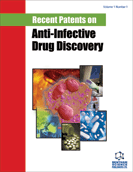Abstract
Malaria is responsible for over 300 million clinical cases annually and claims the lives of approximately 1-2 million. With a disease that has plagued humanity throughout history, one would think that better control measures would be in place to decrease the mortality and morbidity associated with malaria. Due to malaria drug resistance, an increase in the number of clinical infections and deaths is soon likely to be observed. Therefore, there is a push to identify and introduce new drug entities for malaria treatment and prophylaxis. In an effort to develop new malaria drugs, several different approaches have been implemented. These include the use of drug combinations of either new or existing antimalarials, exploitation of natural products, identification of resistance reversal or sensitizing agents and the targeting of specific malarial enzymes. Past experience has shown that introduction of the same chemical entities, such as quinolines and antifolates, results in only limited efficacy with resistance developing rapidly within one year of introduction. New approaches to drug discovery should identify novel chemotypes which circumvent the parasites disposition to drug resistance. This review summarizes current efforts in malaria drug discovery as uncovered in recent patent literature.
Keywords: Malaria, Plasmodium, inhibitors, chemotherapy, antimalarials, antimalarial drug resistance reversal agents, natural products as antimalarials, malaria drug optimization, drug discovery
 3
3





















